Ninety-six years after President Calvin Coolidge dedicated Lincoln Memorial Library, the historic building once again finds itself in the spotlight. It’s not just as an example of neoclassical architecture and memories made, but it is a center for thriving 21st century academic life.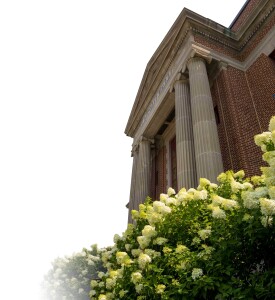
Since 2019, the building has been under a constant stage of construction. What emerged when faculty of the College of Arts, Humanities and Social Sciences and the School of American and Global Studies began moving into their offices July 20 is a building that has “retained the historic elements while being very innovative. This is not just for education today, but also for the future,” according to Lynn Sargeant, dean of the college.
Classes were held in the refurbished Lincoln Hall when fall term began Aug. 21.
A ribbon-cutting and blessing of the building was conducted Sept. 12. The following day there were public tours and a keynote speech by Laurie Fulton, who attended SDSU and went on to become a Washington, D.C., lawyer and U.S. ambassador to Denmark.
From library to music hall
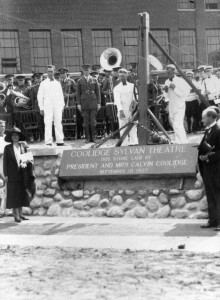 On Sept. 10, 1927, President Coolidge and his wife, Grace, dedicated Lincoln Memorial Library, the first building to bear President Abraham Lincoln’s name on any land-grant campus. Coolidge was returning to the White House after spending the summer in the Black Hills. The president of South Dakota State at the time was Charles Pugsley, who had gotten to know Coolidge when he worked in Washington, D.C., with the U.S. Department of Agriculture.
On Sept. 10, 1927, President Coolidge and his wife, Grace, dedicated Lincoln Memorial Library, the first building to bear President Abraham Lincoln’s name on any land-grant campus. Coolidge was returning to the White House after spending the summer in the Black Hills. The president of South Dakota State at the time was Charles Pugsley, who had gotten to know Coolidge when he worked in Washington, D.C., with the U.S. Department of Agriculture.
For the next 50 years the building served as the place to check out books, check out the opposite sex, study, read newspapers and journals, and observe the quiet demeanor dictated by library ethics of that era.
With the opening of H.M. Briggs Library in 1977, Lincoln Memorial Library, built for $254,200 using a state cigarette tax, was about to transform. Lincoln Music Hall opened in 1979 after a two-year, $350,000 renovation project.
For the next 39 years, a stroll past Lincoln would offer the sounds of opera students practicing arias, pianists limbering their fingers on the keyboards and any number of ensembles rehearsing for the next concert. In 2018, the music department moved into what is now the Oscar Larson Performing Arts Center on the other side of campus.
In that first year, a few classrooms were maintained on the first floor while the second and third floors were vacant.
Renovation effort dates to 2017
Planning for what alumni can view during public tours on Hobo Day weekend was well underway in 2017. The South Dakota Board of Regents approved the preliminary facility statement in August 2017, and Koch Hazard Architects of Sioux Falls was hired Dec. 4, 2017.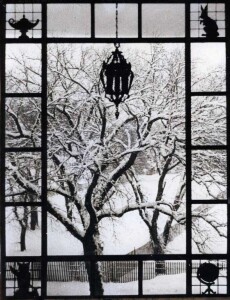
Refurbishing Lincoln Hall has been a $17-million, four-year effort. It’s an energy-efficient building full of ambiance, character and all the latest educational technology, according to Barry Mielke ’02/M.S. ’18, associate vice president for Facilities and Services at SDSU.
Alums who remember Lincoln Memorial Library can find many of the elements that set the building apart when they were students.
Above the north entrance is a window with a frame that incorporates metal images of the learning lamp, a globe, a wise owl and the 1927 version of Jack the Jackrabbit. It is the only window frame not replaced in the project, Mielke said. The other steel window frames were replaced with thermally broken aluminum frames, according to Koch Hazard architect Stacey McMahan.
Architects studied original drawings
McMahan, who has been with the project since 2017, said, “We took time to study the building and the old drawings from the mid-1920s. We stripped back what had been added through the years while respecting the original building form.”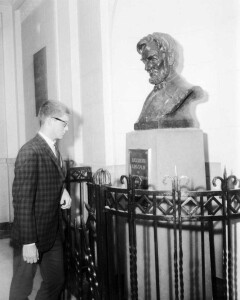
In the lobby off the north entrance is the familiar bust of President Lincoln, which has been in place since 1927 and was created by nationally known sculptor Gilbert Riswold, a 1925 State graduate from Baltic. Inspirational quotes such as Lincoln’s “Free labor insists upon universal education” and Coolidge’s “Books are the foundation of all education” can be seen even better after cleaning and repainting stonework.
Atop marble steps that show the gradual wear of millions of footsteps over nearly a century, alums can rest on two kasota stone benches beneath that ornate north window providing a great view
of the campus green.
Circulation desk still greets second-floor visitors
To the south sits the massive wooden circulation desk. The woodwork was sanded down and restained to return the 30-foot structure to its original glory.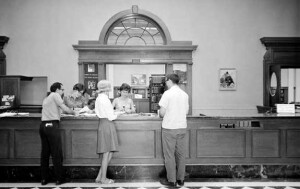
Sargeant said the circulation desk will serve three purposes—a tangible reminder of the building’s historic past, as display or serving space at events and as a student-run help desk.
Beyond the circulation desk is the former library reading room, which later became Peterson Recital Hall and now will serve as the building’s Great Hall. Above it are ornate skylights whose tops were previously covered by a roofing project. Florescent lights had been added above the stained glass to mimic natural light. These were all removed and the shafts up to the skylights painted white to reflect the natural light, McMahan said.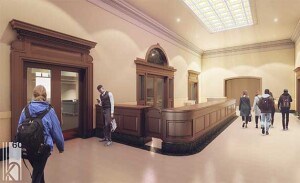
That, plus bright white LED lights, put the room in a whole new light.
Pavilions add 21st century feel
What those lights reveal is something neither those early era librarians nor music department directors Corliss Johnson or David Reynolds could possibly imagine.
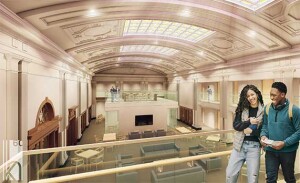
An architect rendering of the Great Hall on the second floor of Lincoln Hall. The space was the reading room when it was Lincoln Library and then became Peterson Recital Hall. Inset photo shows the same area under construction.
The middle of the Great Hall has been converted to a spot for social gatherings. On the east and west ends are project and active learning spaces. Atop them is perhaps the most eye-grabbing feature of the new construction.
Stairs on the back sides of each of the pavilions leads to an upper deck, which has laminated glass railings meant for safety without obstructing the view of the ornate room, McMahan said.
Offices have thoroughly modern look
Jim McKinney wouldn’t recognize his faculty office.
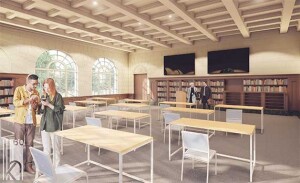
An architect rendering shows the furnished version of a 48-person digital seminar room on the second floor.
Mielke said the faculty offices on the second and third floor were gutted. At 120 square feet, the offices are smaller than before because they won’t be needed for music lessons. They feature ADA accessible doors, bright lighting and modern woodwork with south-facing windows.
“Getting all of the faculty of the School of American and Global Studies under one roof is really important as far as shared mission,” Sargeant said. The school includes degree programs in French, Spanish, German, American Indian studies, history, political science and global studies as well as minors in philosophy, religion and legal studies.
Improvements nobody sees
Much of the refurbishing work involved projects that people won’t notice when they tour Lincoln Hall.
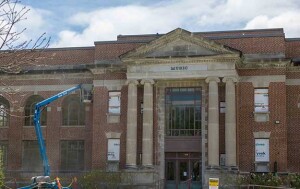 Phase One, which began in 2019, focused on exterior projects, such as stone repairs, tuckpointing, replacing single-pane windows with insulated windows and adding restrooms in the basement and on the second floor.
Phase One, which began in 2019, focused on exterior projects, such as stone repairs, tuckpointing, replacing single-pane windows with insulated windows and adding restrooms in the basement and on the second floor.
The chiller system north of the building was removed and the HVAC connected with the central heating plant on campus for more efficient operation. The previous system wasn’t designed to meet current air exchange standards, Mielke said.
Interior remodeling began in November 2021 and included adding fire sprinklers to the entire building. Asbestos was removed, thermal insulation was added to most exterior walls, and historic lamps were rewired.
Building captures ‘bold, ambitious’ vision
McMahan said the most challenging part of the project was “reworking the heating, cooling and electrical systems to also respect the original building. Because the building was constructed before modern mechanical systems, the high ceilings and windows prevent installing dropped ceilings to accommodate the systems. We pulled the new HVAC system to the interior of the building so you were left with lofty spaces.”
For her, the joy of the project was bringing the historic highlights back to life, such as bringing natural light back to the stained glass under the skylights.
“The reading room is just a majestic space. Opening up the back (south) wall so faculty could interact with people using the reading room is a wonderful example of modernizing the building while respecting original building designs.”
Today’s Lincoln Hall includes three classrooms, four seminar rooms, 35 offices, numerous collaboration
spaces and social gathering locations as well as smart technology throughout.
Sargeant commented, “In 1927 the university had a pretty impressive vision to build this building. It wasn’t a very big university then (917 students), but Lincoln Library captured the university’s ambition for its future. (Current) President (Barry) Dunn’s bold and ambitious vision for SDSU’s next century is captured in the bold and ambitious restoration of Lincoln Hall.”
Dave Graves






